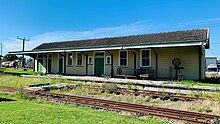Moutohora Branch
Despite all earthworks being carried out by pick and shovel, and although hindered at times by floods, washouts and landslips and (in the later stages) a wartime shortage of materials,[14] progress continued at a slow but steady pace, and the line was opened to Moutohora at 78.5 km by 26 November 1917.
[7] Once at Moutohora, even though over the main divide, there was no easy way for the railway to link up with the rest of the NZR network, as a definitive line for a connection to the Bay of Plenty had never been identified.
[15] By 1920, 13 separate surveys had sought a practical route,[15] but the expensive nature of the works required to provide a descent to the Bay of Plenty always deterred politicians from authorising any further extension of the line.
In his annual report to parliament in 1916, the Minister of Public Works, William Fraser stated "Construction beyond the Kowhai Road [Moutuhora] Station cannot be put in hand until the route of the mainline towards the Bay of Plenty is definitely located.
Road metal from a quarry at Moutohora accounted for 16,400 tonnes of the 1919-1920 total, and continued to be a major component of all freight traffic in following years.
Road metal and livestock continued to provide reasonably large tonnages, but with the onset of the depression both passenger and freight operations fell away, with only a small fraction of the district's primary produce being exported.
The large tender on the ABs limited visibility when running backwards, so to ensure the line could be worked safely by these more powerful engines NZR installed a turning triangle at Moutohora station.
"[5] The development of aerial topdressing led to a short-term increase in freight traffic towards the middle of 1952, as large volumes of superphosphate were required in the district.
The last working train ran a month later, on 14 April, bringing out a final load of road metal for highway improvements that would use the railway alignment once the rails had been lifted.
[3] Five kilometres of the Moutohora branch remain vacant to Makaraka, as the industrial siding to service a fruit storehouse closed in the late 80s.
Just past the northern end of the walkway, the abutments and one of the steel piers of the 30m high Otoko viaduct are clearly visible to the east of the highway.
The Matawai station platform edge can be seen alongside the Matawai-Moutohora road, and the Motu river bridge truss remains in situ.
The East Coast Museum of Technology is the current terminus of what it left of the Gisborne to Moutohora Branch Line, with plans to restore the Makaraka section and run services with GCVR and ECMoT's own Locomotives.
Now owned by the Gisborne City Vintage Railway Incorporated, it has been returned to running order and is regularly steamed to provide excursions.





